
Wondering which e-commerce platform will make your online store grow in the coming 2025: Magento 2 or WooCommerce?
You are on the right page.
There are thousands of e- commerce platforms available to choose from. With that, it is very important to make the right pick, as this will have a major impact on your store’s growth and performance.
Magento 2 and WooCommerce are two giants in this domain, which power millions of online stores worldwide.
As per the latest stats, WooCommerce is used by 4.6 million active stores, and it has a market share of 20.1% of all eCommerce websites. On the other hand, Magento caters to around 132,309 stores worldwide, with a share of 1.45% in the eCommerce platform market.
While WooCommerce’s prominence is an attractive choice for smaller to medium-sized businesses, Magento’s strong features suit enterprise-level requirements and busy sites.
Each platform has different strengths and competencies.
The fact that WooCommerce is deeply integrated with WordPress, giving it a friendly and very extensive plugin ecosystem, makes it a go-to choice for small to medium businesses.
On the contrary, Magento 2 is regarded as a scalable, feature-rich, and secure platform designed for high-traffic and large enterprise stores.
With that being said, this would be the right time to break the ice and explore the features and strengths of Magento 2 and WooCommerce.
1. Dominance in the Market: Who Reigns Supreme?
Undoubtedly, WooCommerce and Magento are the names that surface when speaking about e-commerce platforms. However, which one among these 2 really dominates the market in 2025?
WooCommerce: Global Powerhouse
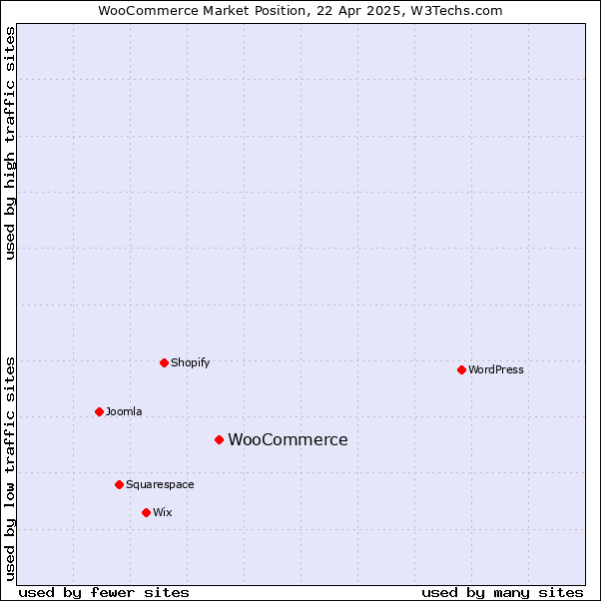
In March 2025, W3Techs reported that WooCommerce powers about 9.1% of all websites worldwide and has a 12.9% market share among content management systems.
This is due in large part to the fact that it integrates so seamlessly with WordPress, which itself drives almost 43% of the world’s websites.
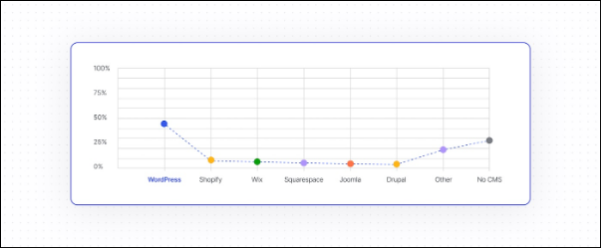 wordpress.com
wordpress.com
Furthermore, the intuitive interface of WooCommerce and its wide plugin ecosystem make it the favored choice of companies who wish to pursue rapid expansion and adaptability.
Magento: Tailored for Enterprises
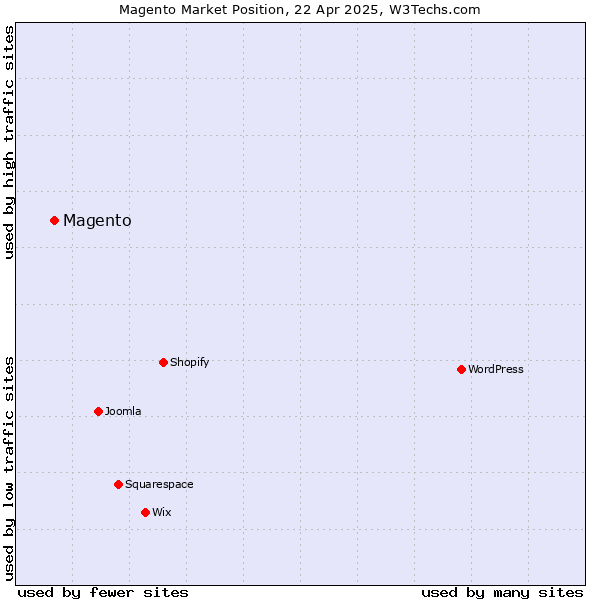
Magento, which is catering to a more niche market, is a very powerful solution for large enterprises and high-traffic sites. It occupies a 0.3% share of all websites, translating to a 0.5% market share among content management systems.
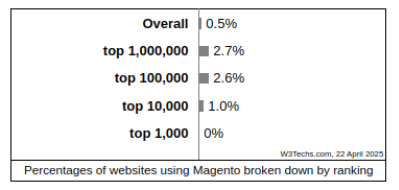
Notably, the adoption of Magento is higher among leading websites, with 2.7 percent of the top 1 million using it. This tells us that it is heavily present in the enterprise sector, where scalability and a range of strong features are essential.
Thus, to summarize, WooCommerce has a favorable market share and accessibility, which makes it a good choice for businesses that prioritize ease of use and quick deployment. This is the reason many businesses migrate Magento store to WooCommerce.
2. Performance & Scalability: Which Platform Powers Growth Better?
In 2025, both Magento 2 and WooCommerce will have advanced greatly in performance and scalability. However, they cater to different business needs and are of different sizes.
WooCommerce: Optimized for Small to Medium-Sized Businesses
For small to medium-sized businesses, WooCommerce is an intuitive platform when used with WordPress. It uses plugins like W3 Total Cache and can be integrated with Redis or Memcached for increased performance.
However, with your store growing, it is necessary to invest in robust hosting solutions to ensure optimal performance.

In recent times, WooCommerce has developed a High-Performance Order Storage (HPOS) system that helps improve order processing and checkout speeds. Early tests indicate a 5x faster order processing and a 1.5x faster checkout, which is by far the most scalable WooCommerce has ever been.
Magento 2: Built for Enterprise-Level Performance
Due to its robust architecture, Magento 2 is well known for being the go-to software for large-scale businesses. It also supports superior caching facilities like Full Page Cache (FPC), Varnish, Redis and Memcached, improving load speeds and effectively handling high traffic.
This infrastructure enables Magento to deal with its large and complex product catalogs and operations effortlessly.
As of 2025, Magento 2 is still evolving and has introduced the feature of headless commerce, which isolates the front and back end, allowing for faster load times and more flexibility in the user experience. This is particularly helpful to businesses trying to deliver a seamless multichannel experience.
Overall, Magento 2 is unparalleled in terms of scalability and performance, especially for large enterprises with complex requirements. In contrast, WooCommerce is a brilliant and flexible solution for small to medium-sized businesses.
3. Customization & Flexibility: Tailoring Your eCommerce Experience
Having an online store that can be personalized and modified is necessary for succeeding in the eCommerce landscape in 2025.
Hence, let us dive deep into how Magento 2 and WooCommerce attempt to meet the required needs.
WooCommerce: Flexibility within Reach
Pre-equipped with thousands of prebuilt themes and plugins, WooCommerce is built on the WordPress engine. Despite offering much customization, it may not meet Magento’s depth for complex eCommerce needs.
WooCommerce has, however, evolved to be more flexible. With the introduction of the High-Performance Order Storage (HPOS) system, the order processing speeds have been increased, so the system is more scalable to a growing business. In addition, since the platform is integrated with almost every page builder, store owners can design their storefronts without digging into the code.
Magento 2: Pinnacle of Customization
Magento 2 stands out for its unparalleled customization capabilities. Its modular architecture allows developers to shape every aspect of the store, from user experience to third-party integrations. It is precisely this flexibility that is suitable for businesses that have specific conditions.
More recently, Magento has become even more flexible thanks to the latest advancements.
Now, Progressive Web Apps (PWAs) and headless commerce are supported by the platform, so businesses can have a seamless user experience across all devices. Magento also has a vast marketplace that offers an array of extensions and themes that can be used for deep customization without extensive coding.
Overall, if you have a large, complex business to run, Magento 2’s ability for advanced customization makes you set. However, WooCommerce’s simplicity and flexibility provide a perfect fit for smaller or growing stores.
Everything is about what works best with your goals and resources!
4. Ease of Use: Navigating Your E-commerce Journey
The features of an e-commerce platform are not the only considerations to take into account; how easily they can be used is also an important one. Let’s find out which of WooCommerce and Magento 2 will please users even more.
WooCommerce: Intuitive and Accessible
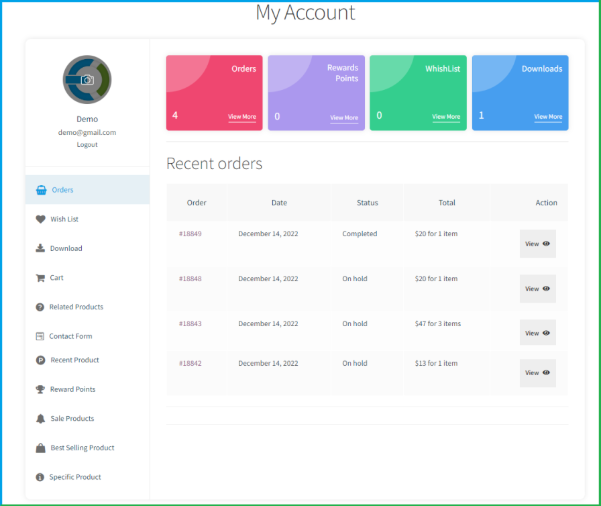
With quite a user-friendly interface, WooCommerce built upon WordPress is very convenient, especially for those already well aware of WordPress. Its dashboard is very intuitive and does not require users to have technical knowledge to set up and manage the stores.
Furthermore, as the platform is integrated with WordPress, users can use a wide variety of themes and plugins to simply customize their stores.
Today, in 2025, WooCommerce has incorporated its core features, making less of its dependency on third-party extensions and creating a better user experience.
Magento 2: Powerful but Complex
Regarding features and scalability, Magento 2 is no stranger to large enterprises.
This power, however, comes with a steeper learning curve.
As its highly sophisticated architecture and backend often need a professional hand, this is more appropriate for businesses that employ a dedicated development team.
Often, users discover that to manage Magento 2 well, they must know the ropes concerning web development and database management.
WooCommerce is a user-friendly platform if the focus is on a simple and easy-to-navigate platform and one that doesn’t require any technical expertise. On the other hand, if your business needs the most advanced features and you have the technical staff to run those, Magento 2 offers a powerful, albeit more complex, solution.
5. SEO & Marketing Mastery: Elevate Your Store’s Visibility and Sales
If you are operating in the e-commerce world, you must have a strong SEO and marketing strategy. Magento 2 and WooCommerce are both extremely powerful tools, but they are designed for different needs at different levels of expertise.
WooCommerce: Leveraging WordPress’s SEO Strengths
WordPress’s solid SEO setup provides a great foundation for WooCommerce.
With plugins like Yoast SEO, users can optimize their stores effectively. The Yoast WooCommerce SEO plugin increases the visibility of the products by adding structured data and improving breadcrumbs and XML sitemaps.
However, there are several advanced features, like AI-generated meta descriptions and advanced schema implementations, that may require additional plugins or premium versions.
Magento 2: Advanced SEO and Marketing Tools Built-In
The SEO functionality offered through Magento 2 is well known. Its off-the-box offering includes customizable URLs, meta tags, XML sitemaps, and rich snippets. These features boost your website visibility in search engine results and consequently increase click-through rates and decrease bounce rates.
In addition to that, Magento 2 lets you markup products using structured data with Schema.org, improving the way your products look on search pages.
Even more, the platform provides a way to modify the robots.txt file on your server directly from your admin panel so that the search engines know which pages to index.
Lastly, Magento 2 offers many brilliant marketing tools for upselling, cross-selling and customer segmentation, so it’s possible to create a customized shopping experience that boosts sales.
If you have your sights set on robust, out-of-the-box SEO and blow your competitors away with multiple advanced marketing options, then Magento 2 is your top choice. However, for a more flexible, plugin-rich SEO journey, WooCommerce offers great value, especially if you are an experienced WordPress user.
6. Fortifying Your Online Store: Security Showdown

While cybersecurity has come a long way, ransomware was the biggest threat in 2023, with over 72 percent of cyberattacks being fueled by the attack. So, even the most advanced defenses are no match for the determined hacker.
For this reason, in the modern, fast-paced digital marketplace, keeping your e-commerce safe isn’t optional anymore. Considering online security, both Magento 2 and WooCommerce aim for security, but they present different ways.
WooCommerce: Flexible but Vigilant
Although WooCommce is based on WordPress, it requires proactive security measures.
- Plugin Management: WooCommerce often depends on third-party plugins for their functionality. This allows you to customize your website, but vulnerability can also be introduced. Thus, the security largely depends on regularly updating the plugins and themes you have installed.
- Security Plugins: Tools such as ‘Security for WooCommerce’ help detect and block fraudulent activities such as location spoofing and creating a VPN/proxy.
- Common Vulnerabilities: WooCommerce sites are commonly vulnerable to such things as outdated software, unsecure plugins, brute force attacks, and SQL injections. Thus, password policies must be strengthened, and regular updates and security audits must be done.
Magento 2: Enterprise-Grade Security
Magento 2 is built from the ground to be secure, with a suite of built-in features at your disposal to keep your eCommerce platform safe.
- Regular Security Patches: Adobe Commerce (Magento 2) addresses multiple vulnerabilities in regular security patches. For instance, the 2.4.6-p10 patch addresses authorization vulnerabilities and adds improvements such as CLI command-based encryption key management.
- Two-Factor Authentication (2FA): Magneto 2 includes 2FA (Two Factor Authentication) with retry attempt limits and lockout times for brutal force attacks.
- Reduced Third-Party Dependencies: Magento Architecture lowers the dependency on third-party extensions, resulting in fewer potential vulnerabilities.
- Security Scanning Tools: Magento has a free security scan tool that scans your site for known vulnerabilities and suggests the required patches.
Magento 2 comes with packaged enterprise-level security that reduces third-party risk. WooCommerce is flexible, but it comes with vigilant plugin management to stay secure. Select the platform that is most in line with your risk tolerance and resources to maintain it on an ongoing. basis
7. Breaking Down the Bill: Cost Comparison
Every potential online store owner needs to fully comprehend all platform expenses prior to their market entry.
Both WooCommerce and Magento 2 provide free bases, but businesses need to spend more than simply installing them.
WooCommerce: Budget-Friendly Flexibility
WooCommerce provides free open-source software installation and WordPress integration, which enables small businesses or startups to enter the market at low costs. However, actual expenses originate from fundamental elements, which include:
- Hosting: Users who want shared hosting for WooCommerce need to pay $7.99 (approx) per month, which amounts to $96 annually for their website needs.
- Domain Name: The cost of registering a new domain typically amounts to $14.99 annually.
- SSL Certificate: Running a secure transaction relies on an SSL certificate, which starts at $69 for yearly use.
- Premium Themes: Although they provide free WooCommerce themes, customers are charged between $20 to $100 per year for premium themes for their advanced functionality and support systems.
- Plugins and Extensions: The total cost can become higher due to premium plugins and extensions that the user selects for their specific functionality needs.
The annual operating expenses for a basic WooCommerce storefront vary from $300 to $1,000 per year based on your selection of additional features and services, according to WP Beginner.
Magento 2: Enterprise-Level Investment
Magento 2 offers two editions: the free Open-Source version and the premium Adobe Commerce (formerly Magento Enterprise).
- Adobe Commerce License: The annual licensing fee for Adobe Commerce varies based on Gross Merchandise Value (GMV):
- Less than $1 million GMV: $22,000
- $1 million–$5 million GMV: $32,000
- $5 million–$10 million GMV: $49,000
- $10 million–$25 million GMV: $75,000
- Over $25 million GMV: $125,000
- Hosting: The hosting requirements for both Magento Open Source and Adobe Commerce need to be strong. Cloud hosting services have a price range between $130 to $2,000 monthly based on the specific infrastructure and service offerings.
- SSL Certificate: The purchase of SSL certificates for Magento Open Source requires separate expenses ranging from $50 to $600 annually.
- Maintenance and Development: Maintenance is something that must be carried out regularly with updates and security patches. The monthly maintenance cost for Magento Open Source can be around $7,500.
On average, a Magento 2 project can cost you at least $48,240 per year, considering license, hosting, SSL, and maintenance.
Choosing the Right eCommerce Platform
Choose WooCommerce if:
- You’re a small to medium-sized business.
- You prefer a user-friendly platform with lower initial costs.
- You’re already familiar with WordPress.
Choose Magento 2 if:
- You’re a large enterprise with complex eCommerce needs.
- You require advanced customization and scalability.
- You have access to technical expertise or a development team.
There are merits to both platforms, and it comes down to your business’s needs, technical capability, and growth plans. So, carefully assess your needs first and select a platform that meets your goals of e-commerce.
